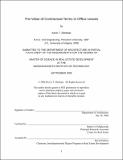The value of contractual terms in office leases
Author(s)
Sheehan, Kevin T. (Kevin Thomas)
DownloadFull printable version (206.5Kb)
Other Contributors
Massachusetts Institute of Technology. Dept. of Architecture.
Advisor
Henry O, Pollakowski.
Terms of use
Metadata
Show full item recordAbstract
This paper uses a comprehensive data set to develop a hedonic model of office rent that estimates values of contractual terms such as tenant improvement allowances, leasing commissions, and options. The model includes variables to control for building characteristics and market conditions, as well as basic lease terms. Although other studies have used a similar approach, the prior work in this area was limited by the lack of data regarding contractual terms. The results show that there is a consistent, upward-sloping, convex term structure of rent. Furthermore, there is an insignificant "size premium" but the "proportion discount" is significant. In general, other variables, such as location variables and qualitative variables behave as expected, with the exception of the expense type dummy variables. Tenant improvement allowances and leasing commissions paid by the landlord do not have a predictable impact on rent at low levels. But high levels of allowances and commissions result in significant rent premiums. These results indicate that lower levels of allowances and commissions may be expected by the market. At higher levels, however, these contractual terms are clearly priced into rent levels. (cont.) Renewal options appear to have positive impacts in some years and negative impacts in other years. Renewal options may represent amenities that are granted to tenants as inducements in weaker leasing markets but are priced in stronger markets. Termination options and rights of first offer/refusal appear to have negative impacts on rent that are somewhat consistent in all years. This is counterintuitive because these options are thought to benefit the tenant. One explanation is that these options are in fact beneficial to the landlord. Further study is necessary to understand the value of these options. Overall, more information about options terms would be beneficial. Information such as the renewal rent, the termination fee, and the size of the offer/refusal space would help us to understand the economic arrangement between the parties and to predict the corresponding impact on rent.
Description
Thesis (S.M.)--Massachusetts Institute of Technology, Dept. of Architecture, 2006. This electronic version was submitted by the student author. The certified thesis is available in the Institute Archives and Special Collections. Includes bibliographical references (leaf 41).
Date issued
2006Department
Massachusetts Institute of Technology. Department of ArchitecturePublisher
Massachusetts Institute of Technology
Keywords
Architecture.